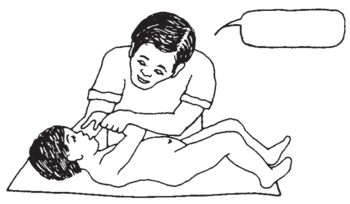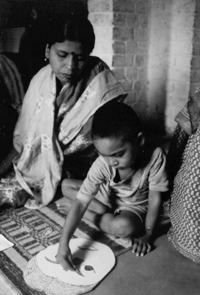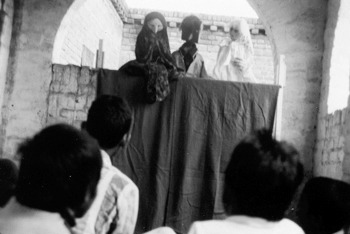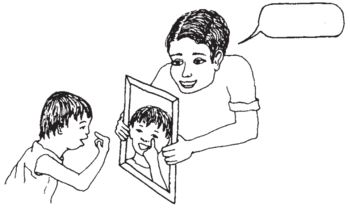Hesperian Health Guides
General Guidelines for Helping a Child’s Development
HealthWiki > Disabled Village Children > Chapter 34: Child Development and Developmental Delay > General Guidelines for Helping a Child’s Development
How a family member or rehabilitation worker relates to a child when trying to teach her new skills can make a big difference in her whole development. It can affect how fast or well she learns the new skill. More importantly, it can influence the child’s confidence, behavior, and readiness to learn.
There are a few simple methods that you can use to help a child gain a better understanding of her own body, prepare her for learning language, and help her relate to other persons in a friendly, cooperative way.
These guidelines are especially helpful when doing early learning activities with children who are developmentally delayed:
| 1. Praise the child a lot. Praise him, hug him lovingly, or give him a little prize when he does something well (or when he makes a good effort). | Explanation Praising success works much better (and is much kinder) than scolding or punishing failure. When the child tries to do something and fails, it is best to ignore it or simply say something like: “Too bad, better luck next time.” |
Take the ball with both hands.
Good! You did it just right! | |
| 2. Talk a lot to the child. Using clear, simple words, say everything that you do with him. | Explanation A child listens to and begins to learn language long before he begins to speak. Although it may seem as though he does not understand or respond, still talk to him a lot. If you think he does not hear, talk to him but also use sign language. Make sure he looks at you as you speak. See “Activities for Communication and Speech.” |

Now touch your nose. |
| 3. When you are helping a child learn a new skill, guide her movements with your hands. | Explanation It usually works better to gently guide the child than to tell her how to do something. If she tries to do something but has difficulty, guiding her hands so that she is successful will make her a lot more eager to learn the skill than if you say “NO—do it like this!” | |||||
| ||||||
|
4. Use a mirror to help the child learn about his body and to use his hands. |
Explanation The mirror helps the child see and recognize parts of his body. It is especially useful for children who have difficulty relating to different parts of their body or knowing where they are. (This can happen in some forms of cognitive delay, cerebral palsy, spinal cord injury, and spina bifida.) | |||||
Where is your eye?
| ||||||
| 5. Use imitation (copying). To teach a new action or skill, do something first and encourage the child to copy you. Turn it into a game. | Explanation Many children with cognitive delay (especially those with Down syndrome) love to copy or imitate the actions of others. This is a good way to teach many things, from physical activities to sounds and words. | |||||
Clap! Clap! Clap!
Aaa! Aaa! Aaa! | ||||||
| 6. Encourage the child to reach out or go for what he wants. | Explanation Even at early stages of development, it is a mistake to always place in his hands what a child wants. Instead, use the child’s desire as a chance to have him use his developing body skills and language skills to get what he wants—by reaching, twisting, rising, creeping, or whatever he is learning to do. | |||||
Come and get your favorite toy.
When it gets too easy, put obstacles in the way—but do not make them too difficult. | ||||||
| 7. Make learning fun. Always look for ways to turn learning activities into play. | Explanation Children learn best and cooperate more when they enjoy and are excited by what they are doing. Keep doing an activity as long as it is fun for the child. As soon as it stops being fun, stop the activity for a while, or change it in some way, to put new adventure and excitement into it. |
2 pieces of wood notched to fit together crosswise
Rub-a-dub- dub. Two girls in a tub...
old tub | |
|
8. Let the child do as much as she can for herself. Help her only as much as is needed. For example, if the child has trouble putting on clothes because of spasticity, help by bending her shoulders and back forward, but let her pull on her clothes herself. |
Explanation This is the “Golden Rule of Rehabilitation.” When a child has trouble doing something or seems clumsy at it, parents often want to “help” by doing it for her. However, for the child’s development, it will help her more to let her do it herself—providing encouragement but assisting only in ways that let her do more for herself. |
Now try to put your other foot in.
Good girl!
| |
| 9. The child often learns best when no teacher is present. | Explanation Children often try hardest when they want something a lot, and no one is there to help. Teaching is important, but so is giving the child a chance to explore, test his own limits, and do things for and by himself. |
|
He never tried to do that before!
Must be thirsty.
|
| 10. Get older children to demonstrate new equipment. | Explanation Some children may refuse to try, or will be afraid of new playthings, aids, or special seating. If another child tries it first, and shows he likes it, the child will often want to try it also. |
Try it, Olga, it's fun! |
REMEMBER: Good teaching will make a difference. How well you teach, play, and express affection is more important than how much time you spend at it.
 |
 |
| A child with cognitive delay learns the parts of a face by placing cut-out cardboard parts on a paper face (Samadhan, Delhi, India) | Puppets are used to teach children with cognitive delay in Samadhan (India). Each puppet wears clothes of one color and has the name of that color. The children learn the puppets’ names — and so begin to learn the colors. |











